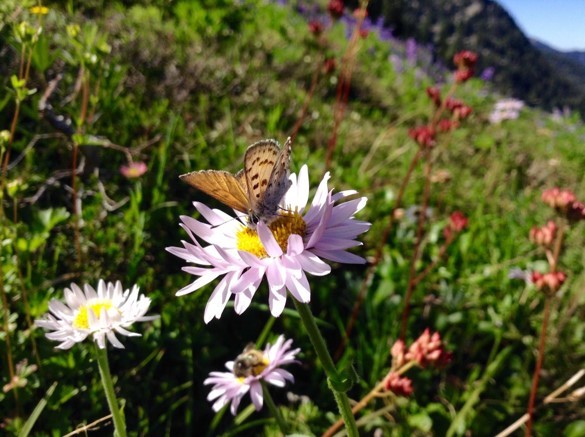
Butterfly Behaviors
When a butterfly flutters by, most of us cannot help but stop and stare at their undeniable beauty. But did you ever wonder, what exactly are these butterflies up to?
While we are probably all familiar with their nectar feeding and pollen spreading habits, here are some explanations of several other common and fascinating behaviors that you might catch butterflies doing this butterfly season:
Basking
Butterflies fly best when their body temperature is about 85-100 degrees. When the air is cooler than this, they use the heat from the sun to warm their bodies through “basking.” Some species may orient themselves perpendicular to the sun with wings all the way open to absorb heat. Others may bask with wings closed, and one side towards the sun. Species active in early spring sometimes have darker areas on their wings to absorb more heat. Some use their wings as solar reflectors rather than absorbers to reflect light down onto the butterfly’s body. Notice this behavior early in the morning, or even when a large cloud passes in front of the sun.
Puddling
Many species of butterflies gather in damp places like wet sand and mud where water accumulates, evaporates, and leaves behind concentrated minerals. This behavior is called “puddling” and almost all butterflies at these sites are males. Drinking water from these mineral rich puddles provides males with extra salt and nutrients necessary for mating. Studies have suggested that these nutrients get passed along to females with sperm in a package called a spermatophore, which aid females in producing eggs. These nutrients may also help males produce a scent that is used in courtship. Puddling does not only occur in areas damp from water; butterflies may also puddle at urination sites of carnivorous animals to supplement the lack of sodium in their mostly herbivorous diet.
Courtship
The main task of an adult butterfly is to find a mate. This isn’t always easy considering butterflies typically exist in low densities. Males actively seek out females in two ways – “perching” and “patrolling.” Perching species perch on rocks or vegetation and wait for females to fly by. When they think they see a female, they will dart out to investigate. Lacking the ability to distinguish fine details from a distance, these males may end up exploring the wrong species, or even the wrong animal, and then return to their perch. Patrolling species fly over a wide area in search of females, exploring all objects that might be potential mates.
When a match is found, the male releases pheromones. If the female is receptive, she will land on the ground to initiate copulation which can take from 10 mins to several hours, where they pair may even take flight together while still joined at the tips of their abdomens!
Egg Laying
A female looking to lay her eggs is an easy behavior to spot. You may see her flying low over vegetation, and repeatedly touching down on various plants looking for a suitable one on which to deposit her eggs. Butterflies are able to use sensory clues, like scratching the leaf surface to release chemicals that help her identify the plants. (A reminder of the importance of planting native plants in your butterfly garden. While flowering ornamentals like butterfly bush may provide a source of nectar, they are not suitable leaves to lay eggs on.) Some species may lay one egg on one leaf, and others may lay their eggs in clusters with a covering that glues them to the leaf or twig, and then forms a protective waterproof shell. Once you start to notice their behavior, you will realize these creatures are just as interesting as they are beautiful.
Here are few local and common species to keep a look out for!
All photos were taken by CJ Urnes on the North Olympic Peninsula within the last month!


Echo BlueCelastrina echo


Margined White Pieris marginalis marginalis

Western White Ribboned Carpet MothMesoleuca gratulata

